Filtration equipment
 BEER FILTERING – beer preparation for distribution to customers
BEER FILTERING – beer preparation for distribution to customers
When is it necessary to filter the beer in a small brewery?
Unfiltered beer is a specific product of small breweries …
Manufacturing and selling of live, unfiltered beer is the main product that differentiates microbrewery production from large breweries. Therefore, in microbreweries the offer of beer without filtration or pasteurization should always be preferred. Fullness of unfiltered beer and its unmistakable taste properties, a high content of substances beneficial to human body, soft haze of live yeast, the view at amazing technology of the brewhouse, draught beer fonts directly connected to the tanks, the smell of malt and hops, with which a brewery restaurant is usually saturated, these are the main assets of which a brewery restaurant appeals customers.
… but is not suitable for distribution to external customers
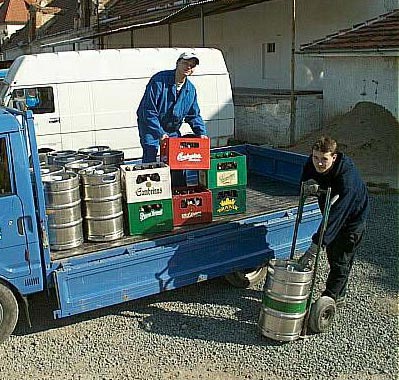 However, if a part of the production of a microbrewery or the entire product range is also designed for other customers or for sale in bottles, petainers and keg-barrels, unfiltered beer is for this purpose quite inappropriate. Beer full of live yeast is very sensitive to temperature change and its distribution outside the brewery, during which it is usually not possible to provide an environment with a constant temperature between 2-5 ° C, leads to rapid changes in sensory characteristics of the original product. Also additional requirements for the care of unfiltered beer are for operators of common restaurants very different from the stereotype practice and it is not easy to enforce the customer to adhere to them.
However, if a part of the production of a microbrewery or the entire product range is also designed for other customers or for sale in bottles, petainers and keg-barrels, unfiltered beer is for this purpose quite inappropriate. Beer full of live yeast is very sensitive to temperature change and its distribution outside the brewery, during which it is usually not possible to provide an environment with a constant temperature between 2-5 ° C, leads to rapid changes in sensory characteristics of the original product. Also additional requirements for the care of unfiltered beer are for operators of common restaurants very different from the stereotype practice and it is not easy to enforce the customer to adhere to them.
If, for example, the owner of the remote restaurant was interested in taking a range of
unfiltered beers from the microbrewery, then he would have to invest heavily in ensuring insulated , actively cooled cellar , and would have to supply this cellar by a vehicle with a cooled space. Beer delivered to buyers must calm down before connecting to taps, ie . stand for several hours, so that roiled yeast could seat to the bottom of the container. Further handling with containers must be very gentle to avoid roiling of beer, for example, by rolling the keg to the tap . The customer must be aware of short consumption limit of unfiltered beer taking the barrels from the stock using the FIFO method , beer with exceeded expiration must not be offered to consumers but discarded.
As a result, the operator of the brewery , delivering unfiltered beer to other restaurants ,reaches short-term sales growth , but at the cost of losing reputation of its beer , since beer offered to customers probably will not exhibit the same quality.
Such requests for additional investment and non- standard manipulation rules beer buyers are usually not willing to meet or their compliance will often be circumvented.
Before the sale outside the brewery the beer needs to get rid of live yeast
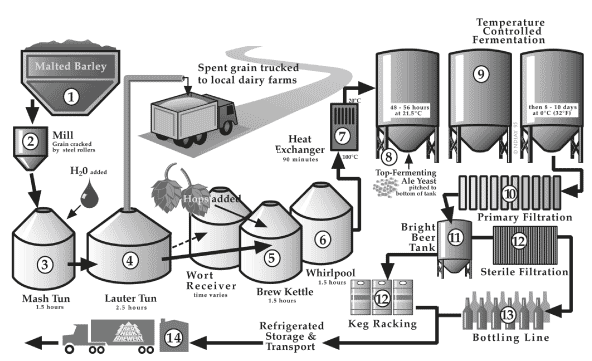 For the above reasons, prior the distribution of beer it is needed to ensure its higher resistance to external influences and extend the expiration of the beer. That is why it is necessary to get rid of live beer yeasts, thereby stopping the fermentation processes in the beer and thus considerably decelerate changes in the sensory properties of beer even if the rules for its transport, distribution and storage are not strickly followed. In other words, it is necessary to make the product durable and long lasting.
For the above reasons, prior the distribution of beer it is needed to ensure its higher resistance to external influences and extend the expiration of the beer. That is why it is necessary to get rid of live beer yeasts, thereby stopping the fermentation processes in the beer and thus considerably decelerate changes in the sensory properties of beer even if the rules for its transport, distribution and storage are not strickly followed. In other words, it is necessary to make the product durable and long lasting.
Increasing the resilience of beer is achieved in two ways:
- Filtration of beer – mechanical removal of live yeast from the beverage
- Pasteurization of beer – temperature sterilization of the beverage (killing of remaining organisms)
Filtration of beer – a proven solution for small breweries with higher production
The microbreweries use to increase the resistance and life extension of beer especially its subsequent filtration without pasteurization. Beer, stripped of most living organisms, although it lacks the body beneficial live yeast, but yet it still keeps its taste and variety of nutritious substances. Unlike pasteurization that beer literally “kills” and turns it in organically inactive fluid, beer filtration is mechanical removal of live yeast from the beverage once or several times by flowing the beer through the filter layer or through multiple filtration layers with decreasing throughput.
Beer filtration is a mechanical removal of live yeast from beverages one or more times, a flow rate of beer through the filter layer or through multiple filtration layers with decreasing throughput.
How to choose a suitable filtration equipment?
When choosing filtration technology , we should bear in mind the goal we want to achieve by filtration of beer.
If we intend to significantly increase the resilience of beer against external influences and extend the life of the beverage for distribution in kegs, it is necessary to use high-quality primary filtration on a plate filter , but better on the diatomeous candle filter , or the modern crossflow filter. We attain high resistance of the drink and extend the life of the beer sold in bottles only by primary and then secondary filtration. The secondary filtration (using microfiltration ) is performed on the extra fine microfilter , plate or candle . By this we achieve in practice the same results as in the pasteurization of beer, but without thermal damage of the beverage.
We supply high quality filters by Czech production with our breweries. :
 1. Plate beer filters
1. Plate beer filters
Beer filtration through a plate filter is the cheapest and easiest way to get rid of most beer live yeast . It is used in a microbrewery of a small and medium size, for which the cost is a primary decision parameter.
 2. Candle diatomaceous earth beer filters
2. Candle diatomaceous earth beer filters
Beer filtration through diatomaceous precoat filter candle is the most common solution of a beer filtration in a microbrewery of medium and large sizes . Beverage filtration is done through kieselguhr filtering layer means on the vertical filter candles . Candle filter is characterized by high filtration efficiency and easy cleaning without necessary dismounting.
 3. Candle beer microfilters
3. Candle beer microfilters
A sterile secondary filtration (microfiltration) is necessary prior to the sale of beer in bottles to the retail network. Microfiltration is carried out in the beer flow through the very fine filter layer of a microfilter. The function of the microfilter is performed either by microfiltration filter inserts in a plate filter, or microcandles in the filter candle.
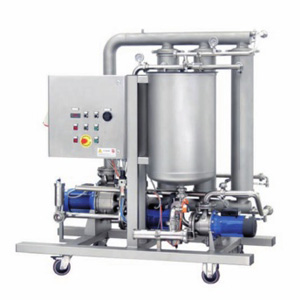 BEER FILTERING – beer preparation for distribution to customers
BEER FILTERING – beer preparation for distribution to customers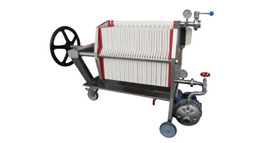 1. Plate beer filters
1. Plate beer filters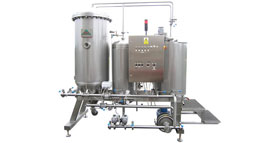 2. Candle diatomaceous earth beer filters
2. Candle diatomaceous earth beer filters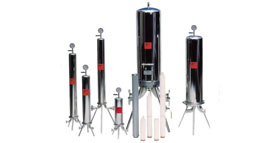 3. Candle beer microfilters
3. Candle beer microfilters 